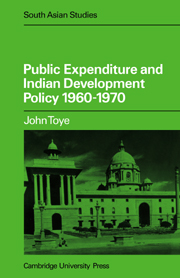Book contents
- Frontmatter
- Contents
- List of Tables
- Preface
- List of Abbreviations
- Introduction
- PART ONE GENERAL
- PART TWO EMPIRICAL EVIDENCE
- 4 The fiscal performance of the public sector
- 5 Public expenditure and the industrial recession
- 6 The degree of public expenditure centralization
- 7 The growth of state governments' spending
- 8 Public investment, public saving and the state governments
- PART THREE CONCLUSIONS
- APPENDICES
- List of works cited
- Index
6 - The degree of public expenditure centralization
from PART TWO - EMPIRICAL EVIDENCE
Published online by Cambridge University Press: 09 January 2010
- Frontmatter
- Contents
- List of Tables
- Preface
- List of Abbreviations
- Introduction
- PART ONE GENERAL
- PART TWO EMPIRICAL EVIDENCE
- 4 The fiscal performance of the public sector
- 5 Public expenditure and the industrial recession
- 6 The degree of public expenditure centralization
- 7 The growth of state governments' spending
- 8 Public investment, public saving and the state governments
- PART THREE CONCLUSIONS
- APPENDICES
- List of works cited
- Index
Summary
CHANGES IN PUBLIC EXPENDITURE CENTRALIZATION
As long as attention focusses on the Indian national economy, ‘the government’ tends to be thought of as a homogeneous institution with a single set of objectives and a single set of policy instruments for their realization. The assumption of a homogeneous government is a considerable simplification even for states, like the United Kingdom, where government is highly centralized. But for India, where a geographically fragmented civil society compelled the adoption of federal government as colonial rule was brought to an end, to imagine that government is homogeneous is wholly inappropriate. A study of India's state accumulation policy, therefore, which failed to come to terms with the different kinds of governments which operate in a federation would have rather little to recommend it.
This elementary proposition needs emphasis only because the majority of economists who have written about India have a marked preference both for the use of nationwide data and for the careful avoidance of any explicit consideration of politics. Because of the numerous data problems involved in making a worthwhile state-level analysis, and because the subject of public expenditure falls in the curious no-man'land between economics and politics as they are conventionally treated, public spending under a federal government is a subject where beaten paths are few, and not always very reliable. Perhaps the most thorough recent study of Indian states' finances has been described by its author himself as ‘an exercise which makes one familiar with all the landmarks … but which is obviously inadequate for those keen to go into details’.
- Type
- Chapter
- Information
- Public Expenditure and Indian Development Policy 1960–70 , pp. 137 - 157Publisher: Cambridge University PressPrint publication year: 1981



